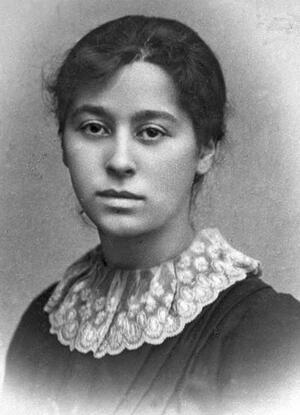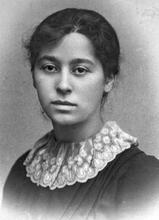Amy Levy
Photograph by Montabone, courtesy of Katherine Solomon.
In 1879, Amy Levy became the second Jewish woman to attend Cambridge and the first at Newnham College. Her early works suggest that she encountered both antisemitic and sexist attitudes at Cambridge. After traveling Europe, Levy returned to London, where she frequented the British Museum’s Reading Room, a meeting-place for women leading innovative lives. Her second novel, Reuben Sachs (1889), was controversial for its perceived antisemitic stereotypes, and Levy was criticized in many Jewish publications. She published “Cohen of Trinity” (1889), which seemed to respond to those accusations and reflected her own struggles as a writer. Her work reflects the autonomous and achievement-oriented ideals of the “New Woman,” as well as her own struggles with depression throughout her twenties. In 1889, she committed suicide.
Overview and Early Life
“Joy is my friend, not sorrow; by strange seas, / In some far land we wandered, long ago,” says Amy Levy in “The Lost Friend.” Here she expresses, as she does in so many poems, her commitment to happiness, an elusive goal despite her many friendships and her successful career as a woman of letters in London in the 1880s. Levy’s sadness and her suicide were primarily the result of what her friend Richard Garnett, British man of letters, called “constitutional melancholy,” yet her letters and other records establish that this gifted writer could be high-spirited and amusing.
Levy was born in London on November 10, 1861, the second of the seven children of Isabel (Levin) Levy and Lewis Levy, a stockbroker. The family, which observed, mildly, the practices of Judaism, had roots in England that went back to the eighteenth century and had strong ties to the native-born Anglo-Jewish community; nevertheless, given the rejection of religious belief in Levy’s poems, Oscar Wilde was right to say that she “ceased to hold the orthodox doctrines of her nation, retaining, however, a strong race feeling.”
Her parents must not have cared about Judaism’s dietary laws and been willing to let their daughter be exposed to untraditional ideas, because Levy was resident at Brighton High School for Girls, a school founded by women’s rights advocates. Her letters show how much she admired Brighton’s headmistress, Edith Creak, Levy’s model for what her era called the New Woman—autonomous and achievement-oriented. While at Brighton, Levy wrote “Xantippe,” a dramatic monologue in which Socrates’ maligned wife gives her point of view on their marriage.
Education and Writing Beginnings
In 1879 Levy became the second Jewish woman to attend Cambridge and the first at Newnham College, which she left in 1881 when her first volume, Xantippe and Other Verse, was published. Two unpublished stories written at Cambridge are revealing: “Leopold Leuniger: a Study” suggests that she encountered antisemitic attitudes there, and “Lallie: a Cambridge Sketch” expresses the strain of being a pioneering woman at the university. A more mature (and published) story, “Between Two Stools” (1883), takes up this theme in a more comic vein.
After leaving Cambridge, Levy traveled in Germany and Switzerland, going back and forth between Europe and London until the end of 1884. While in London, she resided in her parents’ home but lived an independent life. With friends who were writers and social activists, she frequented the British Museum’s Reading Room, a meeting-place for women leading innovative lives. Throughout her twenties Levy, despite battling with episodes of clinical depression, published poems, essays, and stories in London magazines. “Sokratics in the Strand” (1884), a powerful short story, shows her willingness to write about despondency and suicidal impulses.
So does A Minor Poet and Other Verse, which also appeared in 1884. Nearly all these poems are sad, and many are about death; the book’s mood reflects Levy’s own temperament, but she was also influenced by the melancholy poetry written by Victorian women and by German Pessimists, especially Heine. Levy’s lyrics and dramatic monologues stand out from the work of most other women poets of her time in that they raise philosophical questions about whether there is any order or meaning that can justify the anguish of her speakers.
Levy spent the winter of 1886 in Florence. Her father had arranged for her to write a series of articles for The Jewish Chronicle. The first, “The Ghetto in Florence,” reads as though Levy’s visit to the ghetto brought about an awakening to her Jewish heritage. In these essays Levy reclaims her membership in what she calls the Jewish “family”—on her own terms. Not religious, she emphasizes what Jews have in common culturally, particularly humor: “The most hardened Agnostic deserter from the synagogue enjoys its pungency” (“Jewish Humour”). Nor does she refrain from criticism. “Middle-Class Jewish Women of To-Day,” in which Levy makes it clear that she wanted to live an unconventional life and yet consider herself Jewish, challenges the Jewish community’s expectations of women: “The assertion even of comparative freedom on the part of a Jewess often means the severance of the closest ties, both of ‘family and of race.’”
Levy’s visit to Florence in 1886 was pivotal because she met Violet Paget (Vernon Lee), an important figure in the aesthetic movement of the fin de siècle. The love poems Levy sent to Lee (e.g., “To Vernon Lee” and “New Love, New Life”) are revealing, and in letters Levy expressed her admiration. The friendship enabled Levy to become intimate with Lee’s circle of friends, particularly the poet Dorothy Blomfield.
From 1886 through much of 1888, Levy was in an unusually optimistic and energetic frame of mind. This is apparent from her activities on behalf of the University Women’s Club, her vigorous lyrics about urban life, essays such as “Women and Club Life” and “The Poetry of Christina Rossetti” (1888), and the burst of creative energy that produced two innovative stories, “At Prato” and “The Recent Telepathic Occurrence at the British Museum,” and two novels. Romance of a Shop is about four sisters who, in defiance of societal expectations, open a photography business and live on their own when their father dies.
Controversy and Later Life
With one novel out and another, Reuben Sachs, about to be published, Levy revisited Florence in November of 1888; her letters show that she was sad about the end of a romantic relationship with a woman (probably Dorothy Blomfield). Reuben Sachs, about life in the affluent Anglo-Jewish community, appeared in January of 1889, just after she returned to England. It tells of a rising lawyer who loves and then rejects his cousin Judith in favor of a more politically and socially advantageous marriage.
Reuben Sachs was mistakenly perceived by the Jewish press as an attack on Jewish life and this cannot have pleased its author, but Levy may have been more uncomfortable with its reception by gentile reviewers, who mostly read it as a corroboration of longstanding stereotypes about Jews. Few, if any, readers recognized its experimentation with methods that departed from realism or understood that the narrative voices making unpleasant generalizations about Jewish character and life are unreliable; and few noted the longing Judith feels for the warmth and family love of the Jewish community when she is removed from it at the end. Nor did the public grasp that while Jewish life in this novel is materialistic and competitive, Levy’s many allusions to the “gentile” plot in George Eliot’s Daniel Deronda suggest that in regard to its worldly values the Anglo-Jewish community is a microcosm of the larger society.
In the winter of 1889 Levy threw herself into a whirlwind of social and professional activities, writing her third novel, Miss Meredith, which, like many of her short stories, targeted a popular audience. The recollections of those who saw her that spring and summer suggest that after two Jewish newspapers excoriated Reuben Sachs, her mood darkened. In May Levy published “Cohen of Trinity” (1889), a brilliant fiction whose narrator, in this story explicitly a gentile, makes the kind of antisemitic generalizations that had upset Jewish readers of Reuben Sachs. The protagonist, a Jew who has written a book that brings him celebrity, falls into despair when he realizes he will never be understood by the dominant culture.
The controversy over Reuben Sachs probably triggered Levy’s last episode of depression, since she retreated to her parents’ home five days after the Jewish Chronicle attacked Reuben Sachs for the first time, but her personal life was also a disappointment and she was growing increasingly deaf. In seclusion, she corrected the galleys for A London Plane-Tree And Other Verse, whose lyrics are marked by emotional integrity and condensed power. A posthumous story, “Wise in her Generation,” one of her best, indicts British society as a whole for its ruthless individualism.
When Levy committed suicide on September 10, 1889, Oscar Wilde, among others, praised her work: “To write thus at six-and-twenty is given to very few...The world must forgo the full fruition of her power.” And yet Levy was neglected after the 1890s. An edition of most of her work appeared in 1993, sparking a revival of interest; my biography (with a selection of her letters) and an edition of Reuben Sachs published in 2001 should help to keep that spark alive.
Selected Works by Amy Levy
Xantippe and Other Verse (1881).
A Minor Poet and Other Verse (1884).
Romance of a Shop (1888).
Reuben Sachs (1888, rpt. 1971 and 2001).
Miss Meredith (1889).
A London Plane-Tree (1889).
The Complete Novels and Selected Writings of Amy Levy, ed. Melvyn New (1993).
Amy Levy: Critical Essays, edited by Naomi Hetherington and Nadia Valman, Ohio University Press, 2010.
Beckman, Linda Hunt, Amy Levy: Her Life and Letters. Athens: 2000.
Devine, L. “’I Sleep, but My Heart Waketh’: Contiguity between Heinrich Heine’s Imago of the Shulamite and Amy Levy’s ‘Borderland.’” AJS Review vol. 40, no. 2 (November 2016).
Dwor, Richa. “’Poor Old Palace-Prison!’: Jewish Urban Memory in Amy Levy’s ‘The Ghetto at Florence’ (1886).” Partial Answers: Journal of Literature and the History of Ideas vol. 13, no. 1 (January 2015).
Dwor, Richa. “The Racial Romance of Amy Levy’s Reuben Sachs.” English Literature in Transition, 1880-1920 vol. 55, no. 4 (2012).
Hughes, Linda K. “Teaching Amy Levy’s “Xiantippe.” Pedagogy: Critical Approaches to Teaching Literature, Language, Composition, and Culture vol. 16, no 2 (April 2016).
Robertson, Lisa C. “Time and Memory in Amy Levy’s Collegiate Writing: “My Present Mind.” English Literature in Transition, 1880-1920 vol. 61, no. 2 (2018).
Scheinberg, Cynthia, Women’s Poetry and Religion in Victorian England: Jewish Identity and Christian Culture. Cambridge: 2002.
Shapiro, Rebecca. “Amy Levy.” Dictionary of Literary Biography. Ed. William B. Thesing. Late Nineteenth- and Early Twentieth-Century British Women Poets. Detroit: Gale, 2001.
Vadillo, Ana Parejo. “Cosmopolitan Disturbances: Amy Levy in Dresden.” Forum for Modern Languages Studies vol. 53, no. 3 (July 2017).





